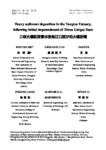Heavy Sediment Deposition in the Yangtze Estuary, Following Initial Impoundment of Three Gorges Dam
| dc.contributor.author | Zhu, B | |
| dc.contributor.author | Luo, G | |
| dc.contributor.author | Yue, Y | |
| dc.contributor.author | Liang, E | |
| dc.contributor.author | Borthwick, Alistair | |
| dc.contributor.author | Li, Y | |
| dc.date.accessioned | 2022-05-24T08:04:05Z | |
| dc.date.available | 2022-05-24T08:04:05Z | |
| dc.date.issued | 2021-12-01 | |
| dc.identifier.issn | 0492-1550 | |
| dc.identifier.uri | http://hdl.handle.net/10026.1/19257 | |
| dc.description.abstract |
Although the initial impoundment of the Three Gorges Dam in 2003 caused a significant reduction in fluvial sediment load, heavy sediment deposition occurred within the Yangtze Estuary during 2002-2009. To gain a clear recognition of this phenomenon, the present study examines the roles of fluvial water and sediment discharges, coastal dynamics and estuarine engineering projects playing in the Yangtze estuarine erosion-deposition process. Results show that runoff discharge is the dominant factor, performing as that the alternate high and low runoff events in the Yangtze basin are associated with the cycles of morphological erosion and deposition in the Yangtze Estuary. Accordingly, the heavy deposition in the Yangtze Estuary during 2002-2009 was related to the hydrologic shift from flood events during 1997-2002 to low discharge events during 2002-2009 happened in watershed, as the landward transport of marine sediment was intensified by the relatively strengthened flood-tide force. Spatial analyses indicate that flood events in the river basin correspond to more deposition in southern subareas in the Yangtze Estuary while low discharge events correspond to more deposition in northern subareas, due to the respectively positive and negative correlations between the ebb partition ratios of north and south branching channels and runoff discharge. Therefore, the heavy deposition in the Yangtze Estuary during 2002- 2009 mainly occurred in northern subareas, under the respectively significant decreases and increases in ebb partition ratios of the north and south branching channels, during the floodto- dry hydrologic shift. As the construction of large cascade dams proceeds in the upper Yangtze, the occurrence frequency of flood events will be reduced, which is likely to cause continuous deposition in the Yangtze Estuary, with the higher amount of sediment deposited in northern subareas. | |
| dc.format.extent | 41-56 | |
| dc.language.iso | en | |
| dc.title | Heavy Sediment Deposition in the Yangtze Estuary, Following Initial Impoundment of Three Gorges Dam | |
| dc.type | journal-article | |
| dc.type | Journal Article | |
| plymouth.issue | 4 | |
| plymouth.volume | 69 | |
| plymouth.publication-status | Published | |
| plymouth.journal | Taiwan Water Conservancy | |
| dc.identifier.doi | 10.6937/TWC.202112/PP_69(4).0003 | |
| plymouth.organisational-group | /Plymouth | |
| plymouth.organisational-group | /Plymouth/Faculty of Science and Engineering | |
| plymouth.organisational-group | /Plymouth/Faculty of Science and Engineering/School of Engineering, Computing and Mathematics | |
| plymouth.organisational-group | /Plymouth/Users by role | |
| plymouth.organisational-group | /Plymouth/Users by role/Academics | |
| dc.rights.embargoperiod | Not known | |
| rioxxterms.versionofrecord | 10.6937/TWC.202112/PP_69(4).0003 | |
| rioxxterms.licenseref.uri | http://www.rioxx.net/licenses/all-rights-reserved | |
| rioxxterms.type | Journal Article/Review |


